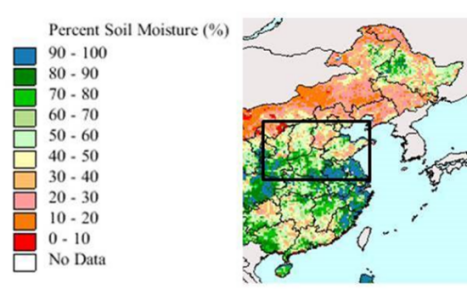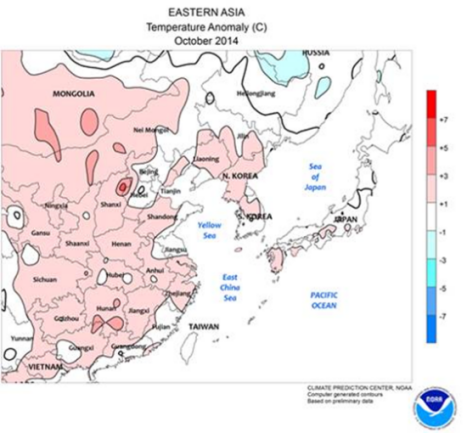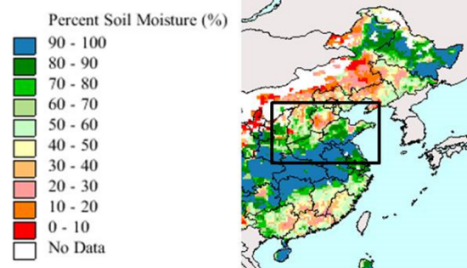Favorable Conditions for China’s 2015/16 Winter Wheat Crop
Summary: China’s 2015/16 winter wheat crop was planted in October and is now in the emergence/tillering stage. The weather has been very favorable for planting and crop development this year. Widespread rainfall in September provided abundant soil moisture, and near to above-normal temperatures in October encouraged vigorous growth. Satellite imagery shows that crop emergence was faster than normal this year, and the crop should be well established before going into dormancy in December.
Stable planted area for 2015, government procurement price unchanged
According to data from China’s Ministry of Agriculture, the winter wheat sown area for 2015/16 was estimated at 22.4 million hectares, slightly higher than last season. Other Chinese government and trade sources have forecast a slight reduction in planted area (down 0.7 to 0.8 percent) for 2015/16, citing the unchanged minimum purchase price and environmental pressures.
In October 2014, the Chinese government set the official minimum purchase price for the 2015 wheat crop at 2360 yuan (US$384.32) per ton, unchanged from 2014. China has set a minimum purchase price for wheat and rice since 2004 in order to stabilize market prices, protect farmers’ income, and boost production. This year, the government purchased 25.35 million tons of wheat from the 2014/15 crop, which helped raise ending stocks to an estimated 63 million tons, the highest level since 2001/02.

Source: Official USDA data, November 2014
Analysts in China report that wheat area is under pressure from urbanization and water shortages. The provincial government of Hebei announced this fall that it plans to reduce irrigated wheat area for 2015 by 50,700 hectares in order to protect the declining water supply. Wheat area is also expected to drop in Gansu province in 2015 due to water shortages and low profits compared to corn. On the other hand, wheat area was expected to remain stable in Henan and increase sightly in Shandong province.
Weather Situation
Weather and soil moisture conditions were generally favorable for the planting and emergence of China’s 2015/16 winter wheat crop. Above-normal rainfall from August to mid-September ended a summer drought that had affected the North China Plain earlier in the summer. The heavy rain delayed the summer harvest, which in turn delayed the start of this year’s winter planting season (normally around September 30) by several days.
September 30, 2014 – Good soil moisture for winter wheat planting/emergence

Source: FAS Crop Explorer http://www.pecad.fas.usda.gov/cropexplorer/
According to the Ministry of Agriculture, an estimated 12 percent of the winter wheat was planted as of October 8, about 5 percentage points slower than normal. However, mostly warm and dry weather in October allowed planting to progress quickly. Planting was 62 percent complete as of October 16, a faster pace than last year, and was essentially finished by the first week of November. Mild temperatures continued through the first two weeks of November.
Warm temperatures in October favored wheat growth

Soil moisture levels remained favorable in most areas through October, although the northern wheat region (particularly Hebei) was drier than normal and the crop may have needed supplemental irrigation at planting. In contrast, the weather in southwest China was wetter than normal in October, which had a detrimental impact on winter wheat emergence and growth. This region (which includes the provinces of Sichuan, Hubei, Guizhou, and Yunnan) accounts for less than 10 percent of China’s total wheat output.
October 31, 2014 - Wet in southern wheat region, small area of dryness in the north

Source: FAS Crop Explorer http://www.pecad.fas.usda.gov/cropexplorer/
The combination of mild temperatures and adequate to abundant soil moisture promoted rapid emergence and development on the North China Plain. Satellite imagery and satellite-derived vegetative index (NDVI) maps and charts clearly show that wheat growth in October/November was faster and more vigorous than average.

Green = above average growth

NDVI charts (red line = wheat emergence in October/November 2014 compared to normal)
Background: China is one of the world’s most important wheat-producing countries. In 2014/15, China’s wheat area (24.1 million hectares) ranked third behind India (30.6 million) and the EU (26.8 million). However, China’s wheat yield (5.23 MT/Ha) is among the highest in the world, and its estimated production (126.0 million tons) put it in second place after the European Union (EU). Winter wheat accounts for about 95 percent of China’s total wheat output, with more than 75 percent of the crop produced in 5 provinces located on the North China Plain (Henan, Shandong, Hebei, Anhui, and Jiangsu).
China’s winter wheat crop is planted from late September through October and harvested in May/June the following year. Although most of the crop is grown on the North China Plain, winter wheat is also produced in western China and parts of the Yangtze basin and southwest China. A small spring wheat crop (less than 5 percent of total production) is grown in northern and western regions. A majority of the crop receives irrigation at some point during the growing season, and average yields are significantly higher than the world average.

Source: USDA – PSD Online (https://apps.fas.usda.gov/psdonline/)
Planted area increased by 1.5 million hectares between 2005/06 and 2009/10 but has been stable since then. Wheat yield has increased steadily over the past decade despite periodic droughts. The high yields were achieved with the help of widespread irrigation, the development of high-yielding varieties, adequate supply of inputs, and strong government financial support. Production for 2014/15 is estimated at a record 126.0 million tons and the quality of the crop was said to be higher than the 2013/14 crop, which was damaged by drought and disease.
The USDA will issue its initial 2015/16 wheat production estimates in May 2015. Current USDA area and production estimates for grains and other agricultural commodities are available at Foreign Agricultural Service’s World Agricultural Production circular or at Foreign Agricultural Service’s PSD Online.
|

